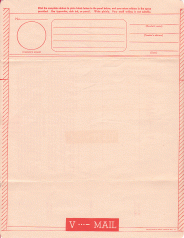There were many forms of technology during World War II. Many, but not all, of these were new developments, never used in previous wars. The types of communication during World War II included: Propaganda, Newspapers/Magazines, Radio, Airplanes, Telegraph, Telephones, Mail, Animals, and Cryptology. Each one specializing is specific situations allowing Americans to be more connected with one another than ever before.
Propaganda
There were many forms of propaganda used. Movies, commercials, and posters were the most popular. They all had the same general message though, which was to do whatever you could to help win the war. Whether it was women helping in the workforce while their husbands are away fighting the war or Americans remaining loyal to their country and not talking to possible enemies, which is where one of the slogans “Loose lips might sink ships” comes from. An example of a movie that was a form of propaganda was “The Best Year of Our Lives.” “Almost immediately, the film attracted large crowds, eager to understand the ways in which the war had changed American society.” (Mintz & Kellogg, 170)


Newspapers and Magazines
Newspapers and Magazines now gave a sense of opinion to the public with the idea of editorials and letter-to-the-editors along with their initial role which was just to spread news to the public. “Letters-to-the-editors of various newspapers throughout Arkansas reflected strong feelings against the employment of married women in the nation’s defense industries.” (Smith, 21) People would now write in about what their stance was on specific, and at times, controversial topics. “Newspapers and magazines gave enormous publicity to stories of wives who had been unfaithful to their servicemen husbands. “(Mintz & Kellogg, 171)
Radio
The radio was “split second communication among all members.” (Britannica) It served as a way for troops and generals to communicate between one another. This could be between generals discussing strategies or it could be between soldiers to generals discussing positions of themselves or enemies. Radio was also another form of propaganda. It helped “to explain to Americans what their country was fighting for and to make the war their own.” (Gerd, 43) Lastly, the radio was the only possible form of communication between the ground and the air for airplanes.
Airplanes
Airplanes served as a way to quickly deliver something. This included care packages or letters from back home. It also helped to deliver messages that couldn’t be delivered on the ground because the trip would be too dangerous since it dealt with the enemy and their territory.

Telegraph
Telegraph was still a popular form of communication during World War II. However it had evolved since the last war. The teletypewriter was a device for transmitting telegraph messages as they are keyed and for printing messages received. With these teletypewriters there were conferences which were called telecons. “A commander or his staff at each end to view on a screen the incoming teletypewriter messages as fast as the characters were received. Questions and answers could be passed rapidly back and forth over the thousands of miles separating them.” (Britannica)
Telephones
Telephones helped to connect the nation to almost immediate communication between one another. It also served as a way for troops to communicate between one another. However, it wasn’t always available between families and troops so mailing letters was still the most popular form of communication between families and their troops.


Mail served as a way for the troops to get caught up on what was going on at home. “Civilians were encouraged to write their service men and women about even the most basic activities. Daily routines, family news, and local gossip kept the armed forces linked to their communities.” (Smithsonian) It helped to boost troop’s moral and keep them from getting lonely. This is also when V Mail became extremely popular. V Mail was a way to quickly deliver a lot of mail to troops.


Animals
Animals were even used as a form of communication during World War II. They helped to deliver hand written messages among troops. Dogs and pigeons were the most effective animals the military used.

Cryptology
Cryptology is the study of codes. Depicting enemy codes was a big part of World War II. Those who depicted were “sworn to secrecy. The penalty for discussing the work outside of approved channels could be death, as it was considered an act of treason during a time of war.” (Wilcox, 8) Cryptology was a whole new language. There were different meanings to every word. Both sides would receive messages through radio of their enemies and they would have to try and decode it. Once they decoded it they would then know their enemy’s positions and/or times of their attacks.
Each form of communication played a unique role in World War II, yet they were each dependent on each another in order for success. Airplanes were one of the main forms of transportation to deliver the V Mail to the soldiers and the only reason airplanes worked was because of the radio. Communication and all of the forms it had to offer during World War II helped to connect the nation as a whole.
Text Sources:
http://www.nasaa-home.org/history/his5comms.htm
Mintz, Steven, and Susan Kellogg. Domestic Revolutions: A Social History of American Family Life. New York: The Free Press, 1988—Ch. 8: Families on the Home Front.
Smith, C. Calvin, “Diluting an Institution: The Social Impact of World War II on the Arkansas Family,” The Arkansas Historical Quarterly, Vol. 39, No. 1 (Spring, 1980), pp. 21-34.
Horten, Gerd. Radio Goes to War: The Cultural Politics of Propaganda During World War II. 2003
Wilcox, Jennifer. Sharing the Burden: Women in Cryptology during World War II. Center for Cryptologic History, National Security Agency. 1998.
http://www.postalmuseum.si.edu/victorymail/letter/index.html
Image Sources:
http://www.mhsvca.org/news/rosie-the-riveter
“Loose lips might sink ships” — and blabby administrations definitely kill American servicemen
http://acepilots.com/planes/main.html
http://en.wikipedia.org/wiki/Field_telephone
http://sarahsundin.blogspot.com/2011/02/love-letters-and-victory-mail.html
